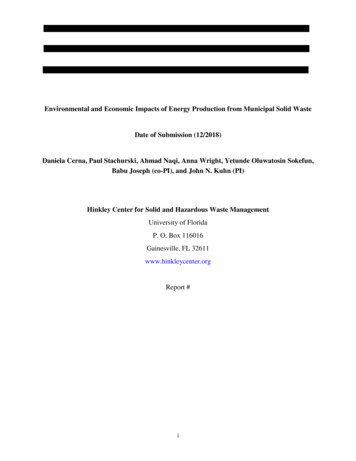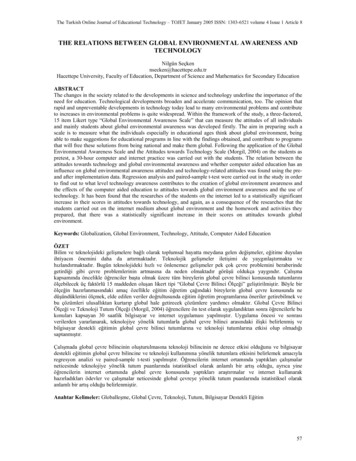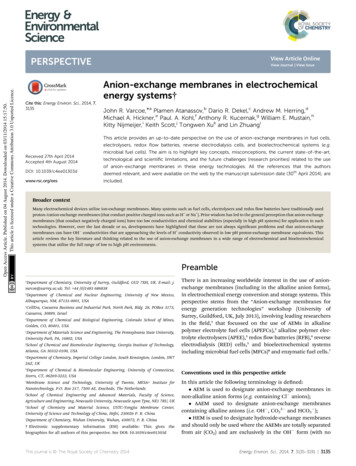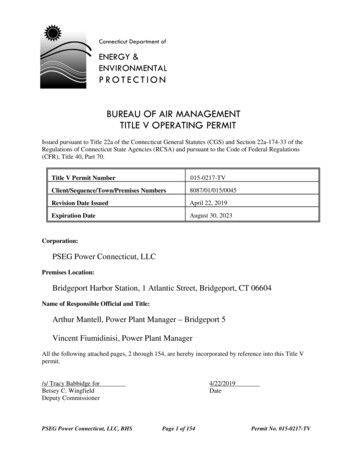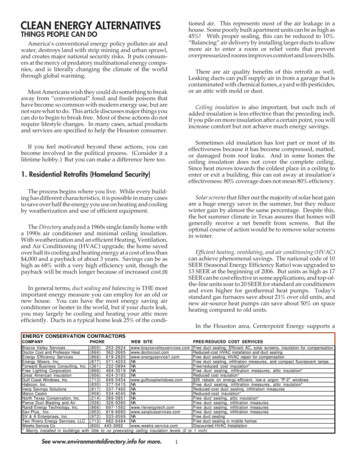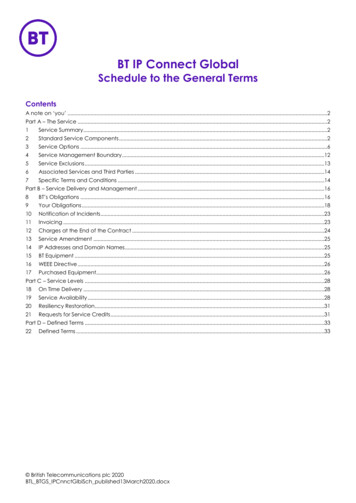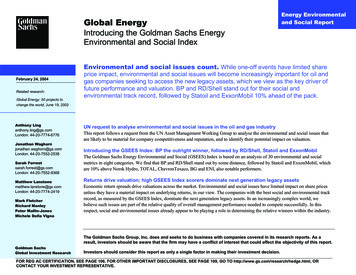
Transcription
Global EnergyIntroducing the Goldman Sachs EnergyEnvironmental and Social Index""February 24, 2004Related research:Global Energy: 50 projects tochange the world, June 19, 2003Anthony Linganthony.ling@gs.comLondon: 44-20-7774-6776Jonathan Waghornjonathan.waghorn@gs.comLondon: 44-20-7552-2538Sarah Forrestsarah.forrest@gs.comLondon: 44-20-7552-9368Matthew Lanstonematthew.lanstone@gs.comLondon: 44-20-7774-2419Mark FletcherRichard ManleyPeter Mallin-JonesMichele Della VignaEnergy Environmentaland Social ReportEnvironmental and social issues count. While one-off events have limited shareprice impact, environmental and social issues will become increasingly important for oil andgas companies seeking to access the new legacy assets, which we view as the key driver offuture performance and valuation. BP and RD/Shell stand out for their social andenvironmental track record, followed by Statoil and ExxonMobil 10% ahead of the pack.UN request to analyse environmental and social issues in the oil and gas industryThis report follows a request from the UN Asset Management Working Group to analyse the environmental and social issues thatare likely to be material for company competitiveness and reputation, and to identify their potential impact on valuation.Introducing the GSEES Index: BP the outright winner, followed by RD/Shell, Statoil and ExxonMobilThe Goldman Sachs Energy Environmental and Social (GSEES) Index is based on an analysis of 30 environmental and socialmetrics in eight categories. We find that BP and RD/Shell stand out by some distance, followed by Statoil and ExxonMobil, whichare 10% above Norsk Hydro, TOTAL, ChevronTexaco, BG and ENI, also notable performers.Returns drive valuation; high GSEES Index scorers dominate next generation legacy assetsEconomic return spreads drive valuations across the market. Environmental and social issues have limited impact on share pricesunless they have a material impact on underlying returns, in our view. The companies with the best social and environmental trackrecord, as measured by the GSEES Index, dominate the next generation legacy assets. In an increasingly complex world, webelieve such issues are part of the relative quality of overall management performance needed to compete successfully. In thisrespect, social and environmental issues already appear to be playing a role in determining the relative winners within the industry.The Goldman Sachs Group, Inc. does and seeks to do business with companies covered in its research reports. As aresult, investors should be aware that the firm may have a conflict of interest that could affect the objectivity of this report.Goldman SachsGlobal Investment ResearchInvestors should consider this report as only a single factor in making their investment decision.FOR REG AC CERTIFICATION, SEE PAGE 106. FOR OTHER IMPORTANT DISCLOSURES, SEE PAGE 109, GO TO http://www.gs.com/research/hedge.html, ORCONTACT YOUR INVESTMENT REPRESENTATIVE.
GlobalGoldman Sachs Global Investment Research - February 24, 2004Energy
GlobalEnergyTable of contents2 Overview: Environmental and social issues count3 The GSEES Index summary scoreboard4 Conclusion: In order to succeed, companies must be managed for the new world5 Majors the most advantaged, led by BP and RD/Shell; Statoil ahead of the Regionals8 Environmental and social issues facing the oil and gas industry17 Valuation and the impact of environmental and social issues on the industry23 The Goldman Sachs Energy Environmental and Social Index27 Non-controllable generic issues; the rise of SRI funds and NGOs30 The impact of Non-Governmental Organisations37 Climate change and pollution in the GSEES Index53 Human Rights in the GSEES Index57 “Corporate Management in the New World” in the GSEES Index75 Impact on gaining new legacy assets – The key differentiating factor in the medium term83 Globalising gas and developing renewables – Strategic decisions for a low carbon world in the long term97 Appendices: Glossary and GSEES Index Criteria107 DisclosuresGoldman Sachs Global Investment Research - February 24, 2004
GlobalEnergyOverview: Environmental and social issues countThis report responds to an invitation from the Asset Management Working Group (AMWG) of the United NationsEnvironment Programme Finance Initiative (UNEP FI). The invitation was to identify specific environmental and socialissues likely to be material for company competitiveness and reputation in the oil and gas industry and, to the extentpossible, to quantify their potential impact on stock prices. We have attempted to analyse not only historical issues, butalso those material to each company’s future prospects. Our analysis breaks down into eight categories:Environmental Climate change PollutionSocial Human rights “Corporate Management in the New World” Management diversity and incentivesInvestment in the futureWorkforceSafetyTransparency and visionIntroducing the Goldman Sachs Energy Environmental and Social IndexWe have created the Goldman Sachs Energy Environmental and Social (GSEES) Index by scoring companies relative to eachother on metrics within the above categories. There are 30 criteria, of which 28 are objective. We have not attempted to score theindustry against other industries. We find significant differences in performance across categories, but some companies scoreconsistently well, notably BP, RD/Shell, Statoil and ExxonMobil. BP and RD/Shell’s scores are 8% higher than that of theirnearest peer, ExxonMobil. Among the Regionals, Statoil is 10% higher than its nearest rivals, Norsk Hydro and BG, which alsopost noteworthy performances, as does ENI. Of the top ten companies in terms of GSEES scores, only OMV lacks materialexposure to new legacy assets. Conversely, Marathon is the only company that scores well in terms of new legacy exposure but notin terms of GSEES. Exhibit 1 shows the relative positioning of all the companies we have analysed. We note that the datadisclosed is not audited and is not consistent across the companies, and that many companies with GSEES Index scores below theaverage of 81 publish limited information on their social and environmental performance.Goldman Sachs Global Investment Research - February 24, 20042
GlobalEnergyThe GSEES Index summary scoreboardA number of distinct groupings can be seen in the GSEES Index. BP and RD/Shell stand out together with Statoil and ExxonMobilin the first tier. A second group of similarly high scoring companies includes Norsk Hydro, TOTAL, ChevronTexaco and BG,closely followed by ENI. The remaining Regionals except MOL and CEPSA form a third tier with between 74 and 85 points. Afourth group is made up of the Emerging Market Regionals and MOL with scores between 56 and 66, while Yukos, Lukoil andCEPSA are at the bottom of the GSEES Index due to their very limited disclosure.Exhibit 1:Company relative positioning on the Goldman Sachs Energy Environmental and Social IndexCompanyBPRD/ShellStatoilExxonMobilNorsk da naMOLSinopecYukosLukoilCEPSAAverageMaximumClimate PollutionChangeHumanRightsManagement Investment WorkforceDiversity andin theIncentivesFutureSafetyTransparencyand VisionGSEES Index Overall Score(Max g MarketRegionalsSource: Company data, Copal Partners, Goldman Sachs Research estimates.Goldman Sachs Global Investment Research - February 24, 20043
GlobalEnergyConclusion: In order to succeed, companies must be managed for the new worldWhile no company in the industry can be said to be incident free, one-off incidents do not have a significant impact on valuation andperformance unless they have a material impact on a company’s return outlook. The energy industry is undergoing profound structuralchange, as highlighted in Exhibit 2. In order to succeed consistently in gaining a dominant position in new projects, we believe thatcompanies must be managed for the new world. In addition to traditional energy industry skills, that means managing a diverse workforcein a socially responsible and acceptable manner with a vision of the evolution of the industry towards the age of gas.Exhibit 2:Goldman Sachs Energy Environmental and Social ConclusionCurrentage ofoil,OPECChanging production mix21% of production non-OPEC in 1970, 42% in2002, 70% of new legacy assets non-OPECLarger, more complex projectsAverage size of new legacy field is 1.7 bnboeand will require US 4 bn in capex to developReduced workforce – the warfor talentIncreasing competitionThe industry is much more competitive post theconsolidation which started in 1998, and the rise ofthe Emerging Market RegionalsTransparency initiativesExtractive Industry Transparency Initiative (EITI) isthe most significant move to improve visibility ofrevenues between industry and governmentsRise of NGOs and SRI fundsFuture ageof gas andbeyondEmployees in US oil and gas industry have slumpedby 30% from 1981-1999 and 55% in E&P aloneThe WTO lists 966 NGOs, Eurosif estimates that 14%of European pension funds are influenced by SRIIncreasing environmentalawarenessLocal governments are increasingly forcing the industryinto more environmentally friendly development e.g., noflaring of gas in West Africa beyond 2008Globalising gas industryOil demand growth is less than half GDP, gas more thanGDP. Within 20 years consumption of gas will overtakeoil with LNG, GTL then hydrogen powered fuel cellsRenewablesFurther attempts to reduce carbon content mean a moveto develop renewable energy sources such as windTo succeed in the rapidly evolving energyindustry we believe companies have to win, andthen operate, larger, more complicated projects,often in new regions. Competition is moreintense, the workforce smaller and externalobservers less forgiving.Ultimately the industry is moving from the ageof oil to the age of gas, and potentially an evenlower carbon world. To succeed in this newworld we believe companies must be bothenvironmentally and socially aware.Source: Company data, Independent Petroleum Association of America, Goldman Sachs research estimates.Goldman Sachs Global Investment Research - February 24, 20044
GlobalEnergyMajors the most advantaged, led by BP and RD/Shell; Statoil ahead of the RegionalsWe believe that success in managing the issues outlined in our index is vital in the management of an energy company in the 21stcentury. It is no surprise that companies scoring well in the GSEES Index are also heavily exposed to next generation legacy assets(the key driver of medium-term performance) and gas projects (the long-term future). More than the Majors (which might beexpected to dominate), it is the appearance of the Regionals that both score well in our Index and have strong asset exposure thathighlights the importance of these issues in winning new projects. OMV (not really an upstream player), Marathon and CNOOCare exceptions to the rule.Exhibit 3:Relative positioning of companies achieving top quartile performance across the GSEES Index, next generation legacy assets, and gas assetsTop ten Goldman SachsEnergy Environmental andSocial (GSEES) IndexTop ten next generationlegacy assets relative toexisting legacy assetsThe medium term driverOMVStatoilNorsk Hydro areNumber 11 on exposureto next generationlegacy arathonRD/ShellBGConocoPhillipsConocoPhillips areNumber 11 on GSEESscoreMajorsCNOOCRegionalsEmerging MarketsTop ten gas assetsrelative to existinggas assetsThe long term driverSource: Company data, Goldman Sachs Research estimates.Goldman Sachs Global Investment Research - February 24, 20045
GlobalEnergyEconomic Return Spreads drive valuation; one-off issues do not impact share prices .In our report Director’s Cut (September 11, 2003) we argued that Economic Return Spreads are the key driver for valuationsacross the market place, and that the oil sector is no different. One-off environmental and social issues have limited impact onshare prices unless they have a material impact on the underlying returns of the company in question. A strong performance insocial and environmental issues is no guarantee of stock market performance – both the FTSE4GOOD and DJ SustainabilityIndices have underperformed the market since inception by 3% and 8% respectively. but social and environmental pressures are becoming increasingly importantIn an increasingly complex world, social and environmental issues are having an increasing impact on companies’ future projectslates. We believe that this will have an increasing impact on future returns, and therefore valuation and share price performance.The increased focus on climate change and corporate governance, together with the rise of socially responsible investment (SRI)managed money and non-governmental organisation (NGO) activity, is taking place at a time when the energy industry isundergoing profound structural changes: the globalisation of the gas industry, the ability to invest on a truly global basis, and thecreation of a more competitive and complicated industry with the rise of a new world order of emerging market players. This couldbe seen as either a threat or an opportunity, and we believe the responses of the companies to these issues will have a growingimpact on performance and valuation.Socially and environmentally responsible companies dominate the industry’s new legacy assetsOn June 19, 2003, we published a report 50 projects to change the world, pinpointing the projects that we believe form the nextgeneration of legacy as
The Goldman Sachs Group, Inc. does and seeks to do business with companies covered in its research reports. As a result, investors should be aware that the firm may have a conflict of interest that could affect the objectivity of this report. Investors should consider this report as only a single factor in making their investment decision. Global Energy Goldman Sachs Global Investment Research .
